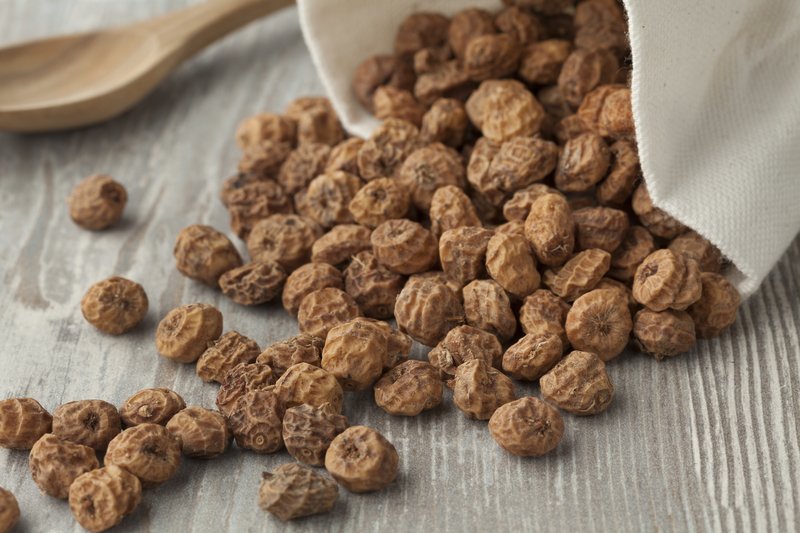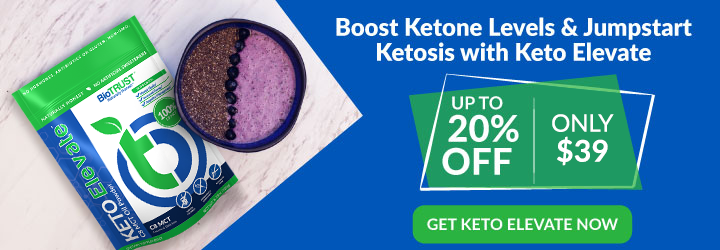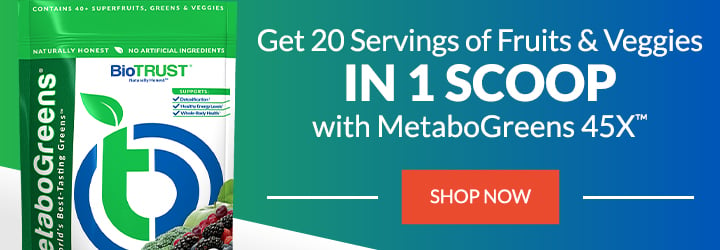The Top 21 Superfoods Trending in 2020

The results are in. According to the most recent annual survey of top registered dietitian nutritionists (RDN’s), “A clean-label and healthy are in—and highly-processed and complex ingredients are out.” 1
Convenience, not surprisingly, continues to be a top driver for consumer purchases. But in 2020, it’s closely followed by “healthy,” even over cost and taste. Consumers are also looking for organic, gluten-free, non-GMO, and dairy-free options—pushing food companies to reevaluate and innovate for healthier options. 1
The top 2020 recommendations from nutritionists surveyed include:
- Eat more vegetables
- Increase fiber intake
- Limit processed and fast foods
- Limit added sugars
- Choose non-caloric drinks
Of course, if you’ve been a part of the BioTRUST community for any length of time, this is likely old—even obvious—news for you. You’ve already ditched highly processed foods and empty calories to make room for nutrient-dense foods. And healthy is already at the top of your list.
You’re ready to go a step further—ready to boost the nutritional content of your meals to the max. So, what should you have on your superfoods list for 2020? Here’s our top 20 superfoods list for this year…
The Top 20 Superfoods List for 2020
1) Turmeric/Curcumin
Long revered as a spice, dye, and health and well-being remedy, turmeric is vital to Indian cuisine, especially curries. Yet the majority of the benefits of turmeric come from the antioxidant within it that gives it its signature yellow color: curcumin. Curcumin has been shown to support brain, heart, and joint health. With more than 3,000 published studies on curcumin, you’d be hard-pressed to find a more well-researched herb. If you’re not in the mood for curry, why not give Golden Milk a try?
2) Chia Seeds
Another superfood that’s far from new is chia seeds, which have been used as a food and remedy as far back as the Aztec civilization. They’re also one of the best whole-food sources of dietary fiber (with 10.6 grams per ounce) along with the omega-3 fat alpha-linolenic acid (5 grams per ounce). Chia seeds are also a good source of protein, vitamins, minerals, and antioxidants. They’ve been shown to support heart health, glycemic control, appetite management, digestive health, and weight loss and can be used in smoothies, added to yogurt and oatmeal, sprinkled on soups and salads, included in baked goods, or made into chia seed pudding.
3) Sumac Spice
One more superfood spice that deserves to be placed in your spice cabinet is sumac. As you can tell by its vibrant red color, it’s rich in polyphenols and flavonoids as well as the antioxidant vitamin C. Sumac is found in many traditional Middle Eastern dishes and has a lemon-like, tangy flavor. Reported health benefits of sumac spice include helping control blood sugar, supporting heart health, and even for relieving pain. Just make sure you don’t confuse sumac spice from the berries of the Rhus coriaria with poison sumac (aka thunderwood), which is relative of poison ivy.
4) Tiger Nuts (nookon or chufa)
Archaeologic have unearthed evidence that tiger nuts were cultivated for thousands of years and were even used in ancient Egypt. Today, they’re produced widely in Africa for their amazing nutrition. Despite the name, they aren’t, however, actually a nut. Rather, they’re small tubers (like a sweet potato).
They’re eaten fresh, semi-dried, fully dried, as a milk-like product (aka horchata), and nut oil. They’re also made into flours and included in granola and nut mixes. Tiger nuts are a rich source of concentrated energy and are very high in healthy fats as well as protein. They provide nutrients like phosphorus, magnesium, iron, and vitamins E and C. They’re perhaps best known as a great source of resistant starch, which promotes digestion and gut health. Tiger nuts have a slightly sweet flavor that’s somewhat like a mixture between chestnuts, almonds, and pecans, but their texture is more like hazelnuts.
5) Golden Berries
If you’re looking for something that’s like a berry but is tart as well as sweet, then golden berries might be the perfect snack for you. When fully ripe, they can be eaten by themselves or on salads or in sauces. These bright orange fruits, which are related to tomatillos, are high in antioxidants and may have some ability to help the body fight inflammation, viruses, and histamines. Golden berries are also high in vitamins A, B, and C and even provide protein and are low in calories (just 74 calories per cup). They’re also high in fiber with 6 grams per cup.
6) MCTs (medium-chain triglycerides)
There are many types of fats, and it’s difficult to keep them all straight. MCTs are a type of functional fat that offers a wide variety of potential benefits for health, including increased energy levels, reduced chance of being stored as fat, increased metabolic rate, enhanced fat burning, greater appetite management, improved weight management, increased ketone bodies, and greater cognitive functioning. Food sources include coconut oil, butter, milk, yogurt, and cheese, yet these foods also provide greater amounts of other types of fats, so many experts recommend supplementation with a quality MCT oil powder to ensure you are getting the recommended amount.
7) Adaptogens
If there’s such a thing as a natural “chill pill,” the closest we have access to is a special category of herbs called “adaptogens.” Adaptogens (typically herbs like ashwagandha, ginseng, Rhodiola rosea, maca, turmeric, and tulsi, and mushrooms like reishi, cordyceps, lion’s mane, chaga, and turkey tail) are promoted as stress regulators. They help support the body’s ability to adapt to its environment by resisting physical, chemical, and biological stress. Typically, they’re used for stress relief, cognitive function, and adrenal health. Some can be eaten, others can be brewed as tea, while others can be put into a pill and taken as supplements.
8) Plant-Based Proteins
As the popularity of plant-based eating is growing (and more people are shifting away from animal products for various reasons), many folks are looking for alternative ways to consume more protein. But you don’t need to be a vegetarian to benefit from plant proteins. In the famous words of influential author Michael Pollan, “Eat food. Not too much. Mostly plants.”
Eating more protein can help increase fat loss, preserve lean body mass, prevent weight regain, optimize muscle protein synthesis, boost metabolic rate, increase fullness, reduce cravings, and help control appetite. Some top choices to include are hemp and pumpkin seeds, lentils, spirulina, or beans.
9) Green Tea and Matcha
Green tea may just be one of the healthiest drinks of all. It may help reduce anxiety, boost cognitive performance (including memory and attention), and improve brain function. The brain-boosting benefits of green tea are likely thanks to compounds like l-theanine. This amino acid helps improve mood and alertness and works especially well with caffeine (also found in green tea). Green tea is also packed with flavonoids (such as kaempferol), which may offer noteworthy antioxidant and anti-inflammatory activity. In addition, it’s been shown to help increase fat burning to help you lose weight, improve physical performance, lower the risk of diabetes, and improve cardiovascular health.
Matcha comes from the same plant as green tea (Camellia sinensis). However, it is grown differently to increase chlorophyll production, which also boosts amino acid content. Then the leaves are ground up into a fine powder, which provides higher caffeine and antioxidant levels than green tea.
10) Exotic Fruits
Eating a more diverse diet of fruits and vegetables supports greater ecological stability, a wider range of vitamins and minerals, a more varied, healthier gut microbiome, improved antioxidant effects, and more. So, if you’re used to eating the same fruits and vegetables, it’s time to look for something a little more exotic. Some to add to the menu include durian, pomegranate, guava, papaya, and dragon fruit.
11) Blueberries
One popular superfood that shows up high on the list year after year is the humble blueberry. This low-calorie, super-nutrient-rich food is a convenient way to increase fiber, vitamins (especially C and K), potassium, and manganese in the diet. What’s most impressive, however, is the exceptionally high levels of flavonoids and antioxidants. Due to their nutritional density, blueberries may help reduce DNA damage to help protect against aging and disease. They’re also great after a workout as they may help reduce muscle damage. Blueberries can be eaten fresh or frozen; just remember to enjoy them often.
12) Collagen
Collagen is the most abundant and arguably the most important protein in the body. In fact, collagen constitutes a whopping 30% of the protein in your body, and that means, aside from water, collagen is the most abundant substance in your body. Maintaining healthy collagen levels is vital for overall health and helps support smooth, healthy, younger-looking skin; strong, healthy fingernails and glossy hair; healthy, supple joints and strong, stable bones; healthy digestion and gut health; strong, healthy tendons and ligaments.
13) Ancient Grains
While wheat is the grain most people are most familiar with, there are numerous other grains with an even longer history to include on your superfoods list for 2020. Quinoa, farro, amaranth, millet, teff, and buckwheat are all ancient grains that are nutrient-rich. Many are also gluten-free and have been revered around the world for their taste and health benefits.
14) Nuts & Seeds
Convenient, delicious, and nutritious, nuts and seeds provide healthy fats (including omega-3s), fiber (which supports healthy blood sugar), numerous vitamins and minerals (such as vitamin E, manganese, and copper), amino acids, and polyphenols (which slow the aging process by combating free radicals)—all shown to help support cognitive function, heart health, and healthy weight. Just remember that nuts and seeds are both nutrient- and calorie-dense. So, watch your serving sizes.
15) Beets
Beets are a good source of fiber, nutrients, and the leading source of nitrates, which is known for its positive effect on circulation. They’re also supportive when detoxing the body. Try this delicious roasted beet salad to enjoy three ingredients from the superfoods list for 2020 in one dish.
16) Fermented Foods (e.g., yogurt, kefir, kimchi, miso, pickles, and kombucha)
This is not a new trend. Rather, fermented foods have been around for literally thousands of years to help preserve foods. Now, however, they’re back in the spotlight because they contain natural probiotics that can support a healthy gut, which is vital for a strong immune system, clear skin, optimal digestion, nutrient absorption, and improved mood.
17) Avocado
Is there any tastier way to get healthy fats, fiber, and key nutrients like vitamins B and E and potassium than avocados? Nutrients that support a healthy brain, skin, and hormones while keeping us full and satiated. Add avocado to your salad, shake, veggie dip, or toast for a dose of creamy, healthy, superfood goodness.
18) Legumes/pulses (e.g., peas, lentils, chickpeas, and beans)
Beans and legumes, like lentils, are sustainable, affordable, and versatile. They make it super-easy to eat more protein and fiber to boot. And they also provide abundant antioxidants. If you have a favorite soup recipe that calls for rice, noodles, or other grains, add lentils or split peas instead—the result is a fantastic texture and a boost in nutrition that can’t be beat.
19) Whey protein
Whey protein is called the king of the proteins for good reason. The two major components of cow’s milk protein are whey, which is rapidly digested, and casein, which is digested much more slowly. Whey makes up 20% of the proteins in milk and is the liquid portion of milk. It is separated from the curd. Whey contains 5 major peptides (including β-lactoglobulin, α-lactalbumin, and glycomacropeptide) and hundreds of low-abundance peptides (including lactoferrin), which together provide a host of benefits, including enhanced muscle recovery, growth, and strength; appetite control; weight management; healthy aging; immune support; improved cardiovascular health.
20) Super Greens
90% of Americans don’t eat enough vegetables and fruits! That’s despite the fact that most people know that they’re essential to a healthy diet and can help reduce the risk of disease, including cardiovascular diseases, diabetes, cancer, and obesity. Enter green powders or “super greens.” Not only do these provide vitamins and minerals but they also provide high amounts of polyphenols, which provide antioxidant and anti-inflammatory properties. They may help improve digestion, support weight management, lower blood sugar, and more. Just make sure you’re choosing a quality brand as not all super greens are the same.
21) Dandelion
Those bright yellow blossoms sprinkled across the lawn are one of the first signs of spring. Although often considered a nuisance, these delicate daisies are much more than weeds. Dandelions have long been used as traditional medicine and are regarded as a symbol of healing and resilience. This is in part because dandelions are so rich in nutrients. For example, dandelions contain over 100 phytochemicals and are not only abundant in vitamins A, C, and K, but also contain vitamin E, folate, and small amounts of other B vitamins. They are even sources for several minerals, including iron, calcium, magnesium, and potassium. On top of that, dandelions possess characteristics that have shown favorable effects on health and wellbeing.








